
The King James Version (KJV), also the King James Bible (KJB) and the Authorized Version (AV), is an Early Modern English translation of the Christian Bible for the Church of England, which was commissioned in 1604 and published in 1611, by sponsorship of King James VI and I. The 80 books of the King James Version include 39 books of the Old Testament, 14 books of Apocrypha, and the 27 books of the New Testament.

Pope Benedict XIV, born Prospero Lorenzo Lambertini, was head of the Catholic Church and ruler of the Papal States from 17 August 1740 to his death in May 1758.

The Vulgate is a late-4th-century Latin translation of the Bible.

Cesare Baronio, C.O. was an Italian Oratorian, cardinal and historian of the Catholic Church. His best-known works are his Annales Ecclesiastici, which appeared in 12 folio volumes (1588–1607). He is under consideration for sainthood and, in 1845, Pope Benedict XIV declared him Venerable.

The Great Bible of 1539 was the first authorised edition of the Bible in English, authorised by King Henry VIII of England to be read aloud in the church services of the Church of England. The Great Bible was prepared by Myles Coverdale, working under commission of Thomas Cromwell, Secretary to Henry VIII and Vicar General. In 1538, Cromwell directed the clergy to provide "one book of the Bible of the largest volume in English, and the same set up in some convenient place within the said church that ye have care of, whereas your parishioners may most commodiously resort to the same and read it."
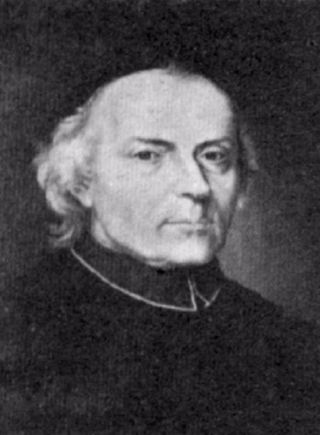
Lodovico Antonio Muratori was an Italian Catholic priest, notable as historian and a leading scholar of his age, and for his discovery of the Muratorian fragment, the earliest known list of New Testament books.

The Douay–Rheims Bible, also known as the Douay–Rheims Version, Rheims–Douai Bible or Douai Bible, and abbreviated as D–R, DRB, and DRV, is a translation of the Bible from the Latin Vulgate into English made by members of the English College, Douai, in the service of the Catholic Church. The New Testament portion was published in Reims, France, in 1582, in one volume with extensive commentary and notes. The Old Testament portion was published in two volumes twenty-seven years later in 1609 and 1610 by the University of Douai. The first volume, covering Genesis to Job, was published in 1609; the second, covering the Book of Psalms to 2 Maccabees plus the three apocryphal books of the Vulgate appendix following the Old Testament, was published in 1610. Marginal notes took up the bulk of the volumes and offered insights on issues of translation, and on the Hebrew and Greek source texts of the Vulgate.
Unigenitus is an apostolic constitution in the form of a papal bull promulgated by Pope Clement XI in 1713. It opened the final phase of the Jansenist controversy in France. Unigenitus censured 101 propositions of Pasquier Quesnel as:
false, captious, ill-sounding, offensive to pious ears, scandalous, pernicious, rash, injurious to the Church and its practices, contumelious to Church and State, seditious, impious, blasphemous, suspected and savouring of heresy, favouring heretics, heresy, and schism, erroneous, bordering on heresy, often condemned, heretical, and reviving various heresies, especially those contained in the famous propositions of Jansenius.
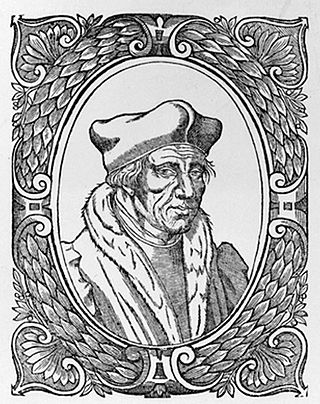
Jacques Lefèvre d'Étaples was a French theologian and a leading figure in French humanism. He was a precursor of the Protestant movement in France. The "d'Étaples" was not part of his name as such, but used to distinguish him from Jacques Lefèvre of Deventer, a less significant contemporary who was a friend and correspondent of Erasmus. Both are also sometimes called by the German version of their name, Jacob/Jakob Faber. He himself had a sometimes tense relationship with Erasmus, whose work on Biblical translation and in theology closely paralleled his own.

The Codex Amiatinus is considered the best-preserved manuscript of the Latin Vulgate version of the Christian Bible. It was produced around 700 in the northeast of England, at the Benedictine Monkwearmouth–Jarrow Abbey in the Kingdom of Northumbria, now South Tyneside, and taken to Italy as a gift for Pope Gregory II in 716. It was one of three giant single-volume Bibles then made at Monkwearmouth–Jarrow, and is the earliest complete one-volume Latin Bible to survive, only the León palimpsest being older. It is the oldest Bible where all the biblical canon present what would be their Vulgate texts.

The Complutensian Polyglot Bible is the name given to the first printed polyglot of the entire Bible. The edition was initiated and financed by Cardinal Francisco Jiménez de Cisneros (1436–1517) and published by Complutense University in Alcalá de Henares, Spain. It includes the first printed editions of the Greek New Testament, the complete Septuagint, and the Targum Onkelos. Of the 600 six-volume sets which were printed, only 123 are known to have survived to date.
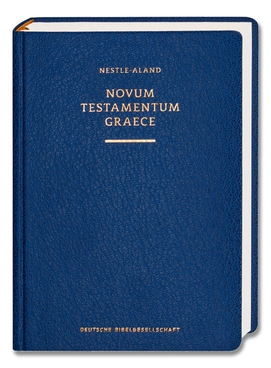
Novum Testamentum Graece is a critical edition of the New Testament in its original Koine Greek, forming the basis of most modern Bible translations and biblical criticism. It is also known as the Nestle–Aland edition after its most influential editors, Eberhard Nestle and Kurt Aland. The text, edited by the Institute for New Testament Textual Research, is currently in its 28th edition, abbreviated NA28.

Carlo Maria Martini was an Italian Jesuit, cardinal of the Catholic Church and a Biblical scholar. He was Archbishop of Milan from 1980 to 2004 and was elevated to the cardinalate in 1983. A towering intellectual figure of the Roman Catholic Church, Martini was the liberal contender for the Papacy in the 2005 conclave, following the death of Pope John Paul II. According to highly placed Vatican sources, Martini received more votes in the first round than Cardinal Joseph Ratzinger, the conservative candidate: 40 to 38. Ratzinger ended up with more votes in subsequent rounds and was elected Pope Benedict XVI.
Baronius Press is a traditional Catholic book publisher. It was founded in London, in 2002 by former St Austin Press editor Ashley Paver and other young Catholics who had previously worked in publishing and printing. The press takes its name from the cardinal Cesare Baronius, a Neapolitan ecclesiastical historian who lived from 1538 to 1607. Its logo is a biretta, which together with a cassock forms the traditional image of a Catholic priest.

The term Catholic Bible can be understood in two ways. More generally, it can refer to a Christian Bible that includes the whole 73-book canon recognized by the Catholic Church, including some of the deuterocanonical books of the Old Testament which are in the Greek Septuagint collection, but which are not present in the Hebrew Masoretic Text collection. More specifically, the term can refer to a version or translation of the Bible which is published with the Catholic Church's approval, in accordance with Catholic canon law.
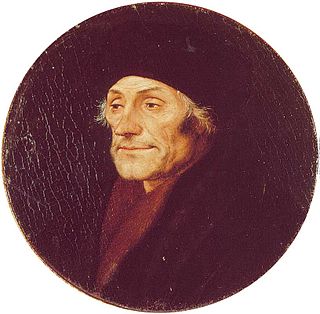
Novum Instrumentum Omne, later called Novum Testamentum Omne, was a bilingual Latin-Greek New Testament with substantial scholarly annotations, and the first printed New Testament of the Greek to be published. It was prepared by Desiderius Erasmus (1466–1536) and printed by Johann Froben (1460–1527) of Basel.
The Bible has been translated into Italian many times since the first printed translation, the so-called Malermi Bible, by Nicolò Malermi in 1471. The CEI Bible published by the Episcopal Conference of Italy is the official version of the Italian Catholic Church. Prior to the initial publication of the CEI edition in 1971, the most common Italian translation of the bible was that of Archbishop Antonio Martini, published from 1769 to 1781. The 1607 Italian translation by Giovanni Diodati is the standard reference used in Italian Protestantism; a revised edition of this translation in modern Italian, Nuova Diodati, was published in 1991.
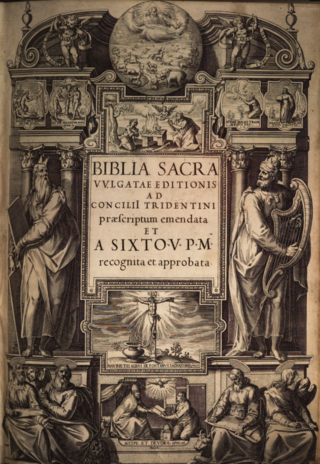
The Sixtine Vulgate or Sistine Vulgate is the edition of the Vulgate—a 4th-century Latin translation of the Bible that was written largely by Jerome—which was published in 1590, prepared by a commission on the orders of Pope Sixtus V and edited by himself. It was the first edition of the Vulgate authorised by a pope. Its official recognition was short-lived; the edition was replaced in 1592 by the Sixto-Clementine Vulgate.

The Sixto-Clementine Vulgate or Clementine Vulgate is an edition of the Latin Vulgate, the official Bible of the Roman Catholic Church. It was the second edition of the Vulgate to be formally authorized by the Catholic Church, the first being the Sixtine Vulgate. The Clementine Vulgate was promulgated in 1592 by Pope Clement VIII, hence its name. The Sixto-Clementine Vulgate was used officially in the Catholic Church until 1979, when the Nova Vulgata was promulgated by Pope John Paul II. The Clementine Vulgate is still in use in the 1962 missal and breviary of the Catholic Church.
Censorship of the Bible includes restrictions and prohibition of possessing, reading, or using the Bible in general or any particular editions or translations of it.
















